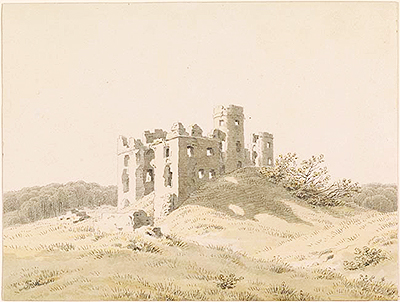Friedrich was a keen draughtsman throughout his career and his drawing studies would provide the backbone to much of his work in other mediums. This section uncovers the different materials that he used and also the types of subjects that the artist chose to concentrate on.
Caspar David Friedrich was most famous for his eye catching landscape paintings but this level of precision was not arrived at overnight. It took years of academic training and practice in his free time in order to master each and every object that you might find in his work. He would sketch trees and mountains in his various notebooks whilst outside and then return to his studio at a later date in order to complete his work in oils. Friedrich saved many of his sketches and clearly held a great love for this art form. In recent years draughtsman have gained far greater respect than they traditionally would have done, with these skills now seen as far more important than just in preparing some a more complex piece in an alternative medium.
Art school is traditionally the point at which a budding artist will concentrate on learning the basics of drawing and Friedrich developed his own ability through regular trips around the countryside with his colleagues whilst living in Copenhagen. During this period he would come into contact with considerable amounts of Dutch art, so perhaps drawings were a part of that. He also disected landscape paintings into their component parts in order to understand better the formation of a composition. Once reduced into individual parts, one might capture each with a quick sketch. Most landscape painters faced a similar challenge of trying to work outdoors but at the same time facing the logistical difficulties of transporting their working materials around. Turner and Constable had the same problems, as did Monet who later created his own garden in an attempt to get around the issue.
Friedrich's move to Dresden was a significant moment in his career and also his artistic development, but he would still continue to make use of a wide variety of different techniques, mediums and materials. It was only later on that he started to narrow his focus down to mainly working in oils almost exclusively, other than the supporting use of sketches to prepare portraits or elements of an upcoming landscape painting. No draughtsman can ever truly stop practicing their art form without losing some of their ability, even Michelangelo would constantly practice his depictions of the human body. He often featured several different studies on the same single leaf of paper, but Friedrich was much less constrained by the availability of paper by the time that his career took hold.
Those looking to understand more about this beautiful technique should study some of the most famous draughtsman in order to compare their differing techniques. Whilst the true Renaissance master, Michelangelo, is perhaps the most celebrated within this art form, there are many others that are worthy of note. Many sketches from previous centuries were not looked after sufficiently well to provide an exhaustive collection for all artists, sadly, but enough of this fragile art form remains from the Renaissance and Baroque periods for us to learn from them, just as the likes of Caspar David Friedrich has done.




